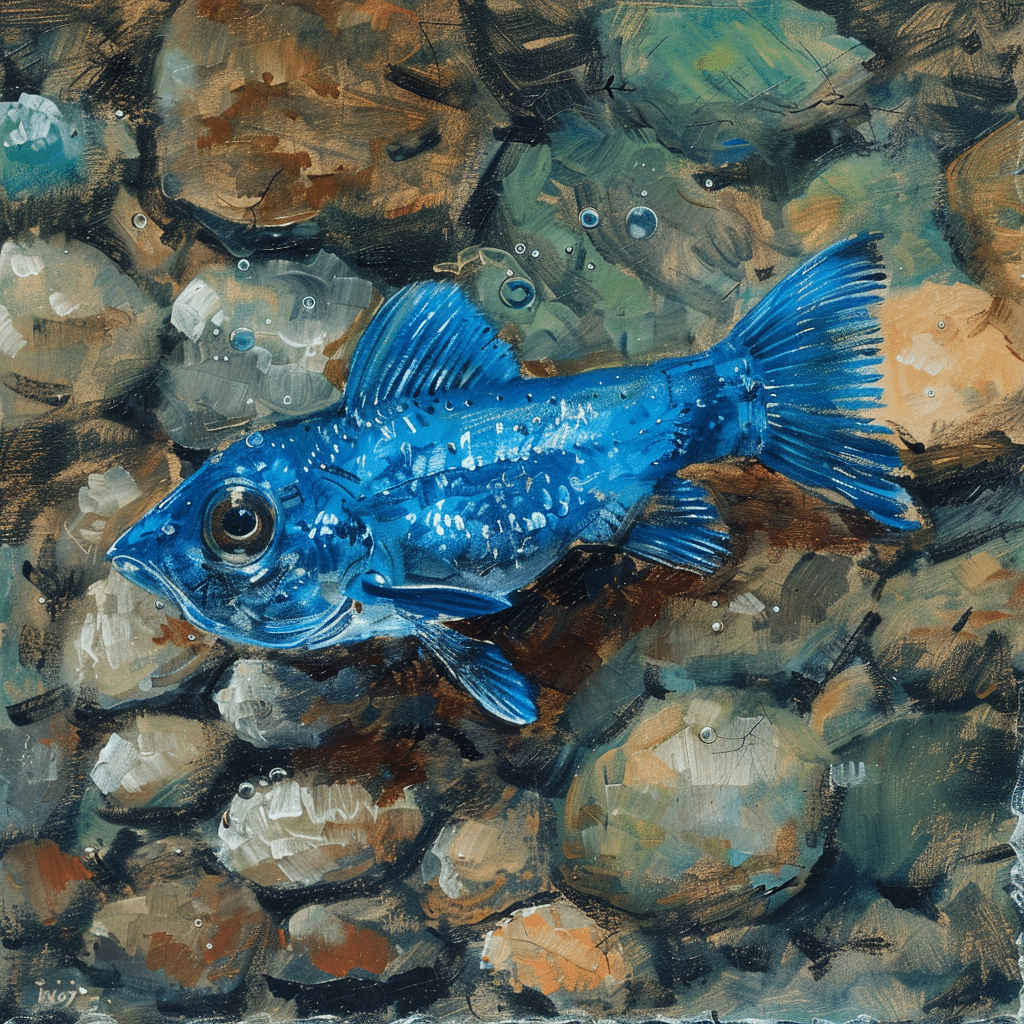In the arid expanses of Nevada’s Mojave Desert, a tiny, iridescent fish flutters on the brink of existence. This isn’t just any fish; it’s the Devils Hole pupfish (Cyprinodon diabolis), a species whose entire world all but fits in a swimming pool, making their fight for survival a topic as heated as the waters they live in. With a population teetering just under 100 individuals, the Devils Hole pupfish’s journey is a critical heartbeat in the vast body of conservation science and a living testament to the tenacity of life itself.
Uncovering the Plight of the Devils Hole Pupfish
Did you know that somewhere in the creases of the vast American wilderness, lives a fish species so rare and so isolated that it is the very metaphor for survival? Devils Hole pupfish’s existence clangs like a bell in the minds of conservationists, signaling an emergency in biodiversity. Found in a unique habitat within Devils Hole, Nevada, these pupfish are the shimmering jewels of the desert. But here’s the rub—the number 263 is etched in the minds of biologists, not as a mere number but as a stark representation of the highest count of this species observed in recent history.

The Natural History of Cyprinodon Diabolis
Let’s dive into the past a little. Imagine these wee fish, millennia ago, finding their niche in what we call today the Devils Hole. Over generations, they have sprinted on an evolutionary treadmill, with nature fine-tuning their abilities precisely for their distinct home. Physically, they stand out with their dainty size, bare bellies without pelvic fins, and a sadly low fecundity. Behaviorally, they’re the pacifists of the fish world, less feisty than their kin. Moreover, they take on the vital role of keeping their habitat’s algae in check—tiny landscapers of their underwater realm.
| Category | Details |
|---|---|
| Scientific Name | Cyprinodon diabolis |
| Common Name | Devils Hole Pupfish |
| Current Population (2022) | Approximately 263 individuals |
| Population Trend | At an all-time low, under 100; prior peak around 550 (1972) |
| Size | Smaller than related species |
| Distinctive Characteristics | No pelvic fins, low fecundity, less aggressive behavior |
| Habitat | Devils Hole, a limestone cave in Nevada’s Mojave Desert |
| Distribution Area | Endemic to Devils Hole with the smallest known range |
| Water Temperature | Constantly around 93°F (34°C) |
| Diet | Algae, invertebrates |
| Breeding Area | Shallow shelf of 215 square feet (20 square meters) |
| Unique Challenges | Extreme heat tolerance, scarce food resources, low oxygen levels |
| Conservation Status | Endangered |
| Protection Measures | Habitat fenced off, viewing only from platform |
| Climate Change Impact | Contributing to decline in population due to habitat changes |
| Genetic Diversity | Low genetic diversity presents a risk under changing conditions |
| Historical Insight | Became isolated less than 1,000 years ago |
| Viewing Opportunities | Devils Hole viewing platform, other pools in the refuge |
A Deep Dive into the Habitat of the Devils Hole Pupfish
You might wonder, what’s so special about this Devil’s abode? Well, imagine a limestone cauldron basking under the desert sun, filled with water that’s a constant 93 degrees Fahrenheit. It’s an intimate affair for the pupfish, with a humble banquet ground of only 215 square feet. Here, oxygen is a luxury, and every nibble of algae and the occasional invertebrate is worth its weight in gold. This isolation has chiseled the pupfish into a formidable survivor, armed with adaptations fit for a life hanging by a thread.

The Conservation Challenges Faced by Cyprinodon Diabolis
Now, hosting a microscopic census isn’t just bad optics—it screams danger. The Devils Hole pupfish is treading water in a gene pool that’s evaporating with climate change’s heat and the meddling ways of Homo sapiens. Their numbers have rallied from 35 to 263, but that’s no comfy cushion. From climate fluctuations to the clumsy steps of human visitors, the threats are real. Thankfully, a fortress of conservation measures is trying to sling a lifebuoy to these little guys.
Advances in Research and Breeding Programs
Talk about a scientific whodunnit! Pupfish research could be its genre, with scientists sleuthing through biology and ecology to save a species. Captive breeding programs have stepped up to the plate, but it’s no walk in the park. Genetic hiccups are par for the course when you’re working with such a shallow gene pool. Yet, thanks to innovation and grit, researchers are cracking the code to give these pupfish a fighting chance.
Balancing Act: Water Rights and the Devils Hole Pupfish
Here’s where it gets murky—the water that gives life to the pupfish is in the crosshairs of a legal tussle. Water rights are as complex as a Gordian knot, with government, local communities, and environmentalists pulling strings. Every drop counts, and water management has become an art of precision, with the Devils Hole pupfish painting the lines of debate.
The Role of Public Awareness and Community Involvement
Once upon a time, the Devils Hole pupfish was just a blip on the radar, a whisper in the wilderness. Now, it’s a chorus of voices championing for their cause. Community initiatives, educational programs, and controlled tourism, are all blending a cocktail of awareness. It’s about making every Joe and Jane realize the worth of a fish no bigger than your thumb.
Emerging Threats and Future Perspectives
Looking down the barrel of the future, the prognosis is a concoction of hope and caution. Climate change looms like a shadow, threatening to tip the balance of an already precarious existence. But let’s not forget; this is a story of resilience. With continued research and adaptive conservation tactics, the future could still hold a shimmer of optimism for the Devils Hole pupfish.
An Ongoing Testament to Resilience
Over the years, the survival of the Devils Hole pupfish has been a rollercoaster worthy of its theme park. With populations swinging like a pendulum, every upward tick is a small victory, a testament to what ‘tough’ really means. It’s a narrative twined with the future of biodiversity and the relentless spirit of life against the odds.
Conclusion: The Path Ahead for Cyprinodon Diabolis
As our tale nears its end, remember the Devils Hole pupfish isn’t just Nevada’s treasure; it’s a global charge. This battle for survival isn’t a spectator sport—it takes a coalition of tactics and the heart of the community. It’s an emblem of wider conservation battles and biodiversity’s intrinsic value.
So, what can you do? Engage, educate, advocate. Whether it’s reducing your carbon footprint, supporting local conservation efforts, or simply spreading the word—the ripples you create could help turn the tide for Cyprinodon diabolis and countless other species that hang in the balance. Let’s take a leaf out of the pupfish’s playbook and swim against the current for the future of our planet.
The Fascinating World of the Devils Hole Pupfish
Let’s dive deep into the captivating saga of the Devils Hole pupfish. These tiny warriors have got moxie you wouldn’t believe, and their story is more riveting than a chart-topping hit from Ashnikko.
Survival in a Watery Fortress
Now, imagine being stuck in a fishbowl with nowhere else to go—yep, that’s the life of the Devils Hole pupfish. They’re living on the edge in what could be nature’s version of a Kegerator , stuck in the desert’s heat, with their very own geothermal pool keeping things just right. But these aren’t some party animals; they’re fighting daily for survival.
A Tiny Population with a Big Problem
Guess what? There are more people in a tiny apartment block than devils hole pupfish in the world right now. We’re talking about a species that’s more exclusive than a rent-to-own housing deal in Beverly Hills. With a crowd that could fit into a modest wedding reception, these fish know all about social bubbles – and we’re not talking about the hydroponic growing Systems kind.
The Last Pupfish Standing
With enough grit and muscle to make Gaspari Nutrition enthusiasts look twice, these little blue swimmers ain’t throwin’ in the towel. Honestly, they’re using their resilience like a pro, living a James Bond adventure 24/7. Think of the struggle of the Devils Hole pupfish as the underwater version of I expect You To die, only they’re beating the odds every single time.
A Fight Against Economic Odds
You think typically high inflation is a sign of economic challenge? That’s child’s play compared to what the Devils Hole pupfish are dealing with. They’re battling water levels, temperature swings, and human interference. Yet, they’re hanging in there like the stock market on a roller-coaster day.
Treading Water in Style
If there were old row Shirts for fish, the Devils Hole pupfish would be the first to wear them. They’ve made fish minimalism a trend long before tiny homes were cool. Living in the smallest natural habitat of any fish in the world, these critters have made the most of what they’ve got and are still swimming in style.
Closing Up:
Listen folks, the Devils Hole pupfish are the rock stars of the fish world, diving headfirst into a pool party where they’re both the guests and the entertainment. They’re tiny titans, battling against the odds in a world that’s pretty much forgotten they exist. But hey, they’ve got spirit, yes they do, and we’re all here cheering them on. Keep on swimming, you pint-sized pioneers!

How rare is the Devils Hole pupfish?
How rare is the Devils Hole pupfish?
Talk about living on the edge – the Devils Hole pupfish are as rare as hen’s teeth! Their numbers wax and wane with the seasons, but right now, we’re talking all-time low, folks—fewer than a hundred of these little swimmers are making a splash in their Nevada home.
What is special about the Devils Hole pupfish?
What is special about the Devils Hole pupfish?
Well, the Devils Hole pupfish is no ordinary fish! Smaller than your average pupfish, these guys are missing their pelvic fins and, bless their hearts, they’re not as fertile. They’re the mellow cousins too, less feisty than others in their family. Think of them as the unique, less-aggressive, petite wonders of the aquatic world.
What happened to the Devils Hole pupfish?
What happened to the Devils Hole pupfish?
Oh, the tale of the Devils Hole pupfish is enough to bring a tear to an environmentalist’s eye. Changes to their habitat, pesky non-native fish moving in, and a bit of an identity crisis with hybridization sent them to the brink of extinction by 1979—gone but not forgotten.
Why did pupfish go extinct?
Why did pupfish go extinct?
The struggle was real for the poor Devil’s Hole pupfish, which knocked on extinction’s door due to a perfect storm of habitat modification, invasive species, and hybridization shenanigans. But don’t worry, they’re fighting a good fight to stick around a bit longer!
What is the rarest fish on earth?
What is the rarest fish on earth?
Well, if you’re angling for the title of rarest fish in the world, look no further than the Devils Hole pupfish. With their itty-bitty habitat in Nevada’s Mojave Desert, these little blue battlers are the aquatic world’s most exclusive residents.
What is the rarest fish in the world 2023?
What is the rarest fish in the world 2023?
As of 2023, cast your line for the Devils Hole pupfish if you’re fishing for the rarest in the world. These guys are real homebodies, living it up in just one Nevada spring – and their numbers? Just enough to throw a small party, not a big shindig.
What is the most inbred fish in the world?
What is the most inbred fish in the world?
When it comes to keeping it all in the family, the Devils Hole pupfish might just top the charts. With an exclusive address and a circle tighter than a school of fish in a sardine can, these little swimmers are swimming in a rather shallow gene pool.
What is at the bottom of Devils Hole?
What is at the bottom of Devils Hole?
At the bottom of Devils Hole lies mysteries galore and, let’s face it, probably a bunch of old algae. It’s the VIP lounge of the Devils Hole pupfish, a deep limestone cave where these tiny blue fish party like there’s no tomorrow on a shelf that’s just about the size of a studio apartment in the city.
How many Devil’s pupfish are left?
How many Devil’s pupfish are left?
Hold onto your hats – the headcount for the Devils Hole pupfish is kind of like a seesaw. As of September 2022, the population was at 263 party-goers. Not exactly a crowd, but hey, it’s better than the solo act they were pulling a few years back!
Are Devils Hole pupfish illegal?
Are Devils Hole pupfish illegal?
You betcha – these Devils Hole pupfish are not up for grabs! They’re listed under the Endangered Species Act, which means it’s a big no-no to try and snag one for your personal aquarium. So, let’s leave the wildlife watching to binoculars and nature docs, okay?
Can you visit Devils Hole pupfish?
Can you visit Devils Hole pupfish?
Sure thing, you can drop by and wave hi to the Devils Hole pupfish, but keep your distance—there’s a fence keeping these endangered swimmers safe. Pack your binoculars for a gander from the viewing platform. And for Pete’s sake, leave the snorkel at home; it’s a look-don’t-touch kind of deal.
Can you buy a Devils Hole pupfish?
Can you buy a Devils Hole pupfish?
Buying a Devils Hole pupfish? That’s as likely as a snowball’s chance in Vegas! These guys are critically endangered and protected by law, so they’re not hitting the pet shop shelves anytime soon. Better to admire these rare gems from afar.
What fish went extinct but came back?
What fish went extinct but came back?
Now, there’s no Lazarus tale in the fish world, but the Devils Hole pupfish came pretty darn close to extinction. Thankfully, with a conservation Hail Mary, they’ve clung on, proving it ain’t over ‘til the fat lady sings—or the last pupfish swims, in this case.
What is the most inbred animal?
What is the most inbred animal?
When it comes to inbreeding, the prize might just go to the Devils Hole pupfish. With a gene pool more like a gene puddle, these fish take the (wedding) cake for keeping it in the family.
What fish is almost extinct?
What fish is almost extinct?
The Devils Hole pupfish is teetering on the thin blue line of extinction, with the population counting just enough fish for a fishbowl get-together. They’re the poster fish for “almost extinct,” so fingers crossed for these blue beauties.





















